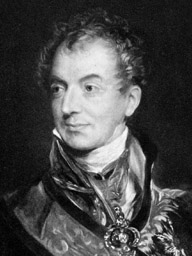Napoleonic wars to "Pre-March Period" - History of Vienna

Prince Metternich (1815)
The city continued to maintain its defence walls, even at a time when other cities in Europe were beginning to "defortify" on a massive scale. What little protection they could actually provide was shown in the early 19th century when Emperor Napoleon Bonaparte occupied Vienna in 1805 and 1809. Upon his departure in autumn 1809 large parts of the fortifications were blasted away to demonstrate his military prowess. Vienna failed to turn this into an opportunity for modernisation. On the contrary, one of the hallmarks of the restoration period in Austrian politics during the era of Chancellor Metternich (until 1848) was the complete absence of any thought of razing the defences. In fact, the destruction of the Napoleonic wars was not sufficiently made use of to launch an urban expansion drive, except, to some extent, in Hofburg Palace, although even there a new city gate, the Äußeres Burgtor, was built. Incidentally, it is the last surviving monument of the old times.
Biedermeier
Particularly during the decades of the so-called "Pre-March Period", that is from the Congress of Vienna (1814 to 1815) to the revolution in March 1848, modernisation of the building stock and infrastructure began to be more and more urgent. Extraordinarily disparate developments and tendencies characterised this pre-revolutionary period. On the one hand, Vienna experienced an age of cultural excellence, and mention must be made in this context of such composers as Beethoven, Schubert or Johann Strauss the Elder, such literary achievements as those of Franz Grillparzer or Ferdinand Raimund, the classic and the popular playwright respectively, and "Biedermeier" art, be it painting or furniture making. On the other hand, the period was marked by the onset of rapid industrialisation combined with grave social problems (for example child labour) and the gradual realisation that the infrastructure was in a deplorable condition (water pipes and sewers, for instance).
Vienna had been devastated repeatedly by severe plague epidemics between the 14th and early 18th centuries, and the massive outbreak of cholera in 1831-32 was an eloquent indication of the highly inadequate drinking water supply of a steadily growing city. By 1500 the city had had some 20,000 inhabitants, by 1754 their number had increased to 175,000, and by the 1840s as many as about 400,000 residents were crowded in the city. Although the figures were well below those of London (959,000 inhabitants by 1800) and Paris (584,000 inhabitants by 1800), the city had nevertheless had to cope with a veritable population explosion.
Industrial revolution
The dawn of the industrial revolution ushered in a new era in Vienna. While the beginnings of steamship navigation on the Danube and of railway lines go back to the Pre-March Period, comprehensive programmes to improve the urban infrastructure were slow to materialise. The city fathers at the time were above all trying to buy properties to minimise the negative effects of the fragmentation of the urban area and administration into many different land ownerships. Obviously, they confronted not only financial limitations. Attempts at modernisation on a Western European scale, such as the construction of meat markets to improve food supplies for the city, met similar difficulties.
City of Vienna | Municipal and provincial archives of Vienna
Contact form
